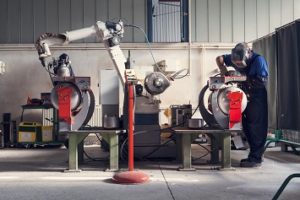In aspiring to achieve International Organisation for Standardization (ISO) 45001, the possibility exists that organisations will replace workers with artificial intelligence (AI) and robots to minimise their hazards and risks.
The Consequences of Good Intentions
ISO 45001 is a standard that enhances the protection of individuals, but could its consequences be to promote the use of AI and robots?
The intention of ISO 45001 is to introduce a global standard relating to the working conditions of workers, such that organisations and their supply chains will have common standards and goals in protecting workers’ health and well-being.
In context, it may be that the adoption of 45001 will encourage a technological leapfrog by organisations. To comply with the standard, organisations may choose to increase the use of AI and robotics, thus eliminating hazards and risks to humans in the workplace. This may ease the way to the organisation’s compliance with 45001, but does it subvert the true intention of 45001?
Déjà Vu
The movement towards the use of AI and robots could result in huge social costs to society by way of unemployment similar to that experienced by workers in Britain in the 19th century displaced by mechanisation. This could have far-reaching societal, political, and financial implications for nations across the global marketplace.
As the extension of the use of robots in the workplace to perform menial repetitive risks spreads, it is very likely that the role of low-paid workers will be undermined. Any increases in the labour costs on businesses to protect and provide for their financial well-being (pensions), to ensure their health and safety (OH&S management and controls), and to provide enhanced protection through employment laws may be counterproductive for the labour force.
Questions may be posed at a strategic level as to whether the reliability and expendability of robots, together with little need for the legal responsibility as to their working standards, will inevitably lead to the substitution of robots for individuals.
As with the introduction of 24-hour production techniques, the investment costs in robotics will realise financial benefits within a short time. For example, in agriculture, the need for nonselective cropping will be obviated by machinery that can sense the readiness of crop products for harvesting. The enabling of multiharvesting of crops will result in enhanced productivity and enhanced profitability such that 24-hour harvesting is feasible. When the realities of the capabilities of these new technologies, allied with the financial savings of dispensing with low-skilled production workers, are grasped, there becomes more of an incentive, if not financial imperative, for the use of AI.
Cost Savings of AI and Robots
Cost savings will be made in the hiring, supervision, and oversight of workers. Such cost savings will include:
- Continuity and standardisation of performance;
- Training and retraining by the upgrade of a microchip;
- Multitasking and the crossover or redeployment of skills made effortless; and
- No need for workers’ representatives, committees, or trade unions’ representatives to be consulted on working practices.
In addition, there will be no psychological or physical stresses to be monitored or alleviated. Language, education, and literacy provide no boundaries for a robot, nor are there any gender or cultural issues to be considered.
Also, dangerous working environments, such as confined spaces or toxic atmospheres, do not present barriers to robots.
A 4th Industrial Revolution
It is truly a 4th industrial revolution that is taking place. With enhanced workers’ rights, pension provisions, and safety regulations designed, quite rightly, to protect workers, the financial costs of such employment and provisions become increasingly unattractive.
With no need to provide health screening, training, accident compensation, or a safe workplace environment, massive savings in such business costs will prove increasingly attractive.
It is already being suggested that demands for an increased minimum wage will lead to robots supplanting the low paid.
Effects Already Being Felt
When factoring in the savings to society of removing the need to provide low-cost housing, healthcare provisions, and the education and training required to sustain a low-skilled migrant workforce, there is a cost/revenue shift towards AI. The wider implications of such a seismic shift in the structure of the workforce could mean the scales are starting to weigh heavily in favour of the use of robots and AI.
The effects on the low paid are starting to be realised, but with rapid advances in robotic thinking and ability to evaluate situations, supervisory and administrative roles within organisations may be threatened. It is estimated that by 2020, 95% of call centre activity could be dealt with by AI capable of responding creatively to consumer interaction.
Will ISO 45001 Intentions Be Subverted?
The ISO 45001 standard with its highly prescribed and standardised requirements for an organisation and its supply chain was not envisaged to displace workers. Nor was the intention for it to be applied to organisations where there could be, and there certainly will be, virtually no human workforce. Where is the point in that? Surely it will only provide a “badge” for those organisations. They will not be contributing to the improvement in working conditions for hard-pressed workers.
It is possible that such a scenario will be advanced and accelerated by increasing regulation and legal requirements. These technological advances are currently under way. In grasping the opportunities they provide, we must be aware of how the world will look in 10 years’ time and what the role of international standards and laws might be.
Carebots, driverless cars, and 24-hour automated agriculture are upon us. Legislators and regulators must be reminded that “the road to hell is paved with good intentions” and created by the law of unintended consequences. Maybe a total rethink of regulatory planning for such a future should start now.
 Chris J Ward, CMIOSH, is an ISO 45001 specialist and an author and lead auditor for OHSAS 18001. He was a principal inspector with U.K.’s Health and Safety Executive (HSE) for 36 years and has experience with a wide range of manufacturing and service sectors. Chris is the author of HSE’s audit tool for inspection of health and safety management used by HSE and local authority inspectors in the U.K. He continues to investigate fatal accidents around the world in the heavy manufacturing and construction sectors. Chris can be reached at chrisjward@iso45001assessment.com. Chris J Ward, CMIOSH, is an ISO 45001 specialist and an author and lead auditor for OHSAS 18001. He was a principal inspector with U.K.’s Health and Safety Executive (HSE) for 36 years and has experience with a wide range of manufacturing and service sectors. Chris is the author of HSE’s audit tool for inspection of health and safety management used by HSE and local authority inspectors in the U.K. He continues to investigate fatal accidents around the world in the heavy manufacturing and construction sectors. Chris can be reached at chrisjward@iso45001assessment.com. |

